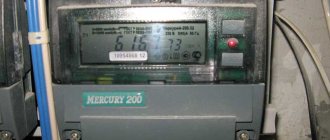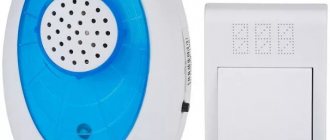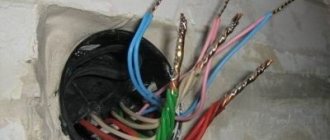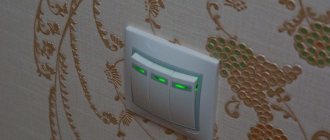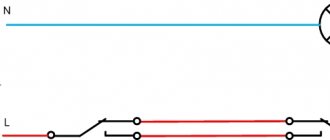What is a wireless switch for?
Remote systems that provide control of certain devices at a distance are becoming increasingly widespread. The wireless wall switch is no exception.
It was created to increase comfort, and for senior citizens and people with disabilities it is absolutely necessary.
Using such a device, you can easily control the lighting in your home, change the brightness, turn lamps on and off.
In addition, thanks to the special design, there is no need to damage the walls or make large holes for installation.
Main conclusions
Remote lighting control is a convenient feature that is gradually appearing in homes. You can control the light using a remote control or smartphone. Also, if the necessary sensors are available, control can be carried out by voice commands, claps, or movement within the sensor’s visibility range. Controlling light from a distance has its pros and cons, which you should familiarize yourself with before installing the system in your home.
Previous
LightingHow to organize lighting in the hall of a cafe, bar or restaurant
Next
LightingDo-it-yourself street lamp: necessary materials, safety requirements, installation
Scope of application
Traditional switches are gradually becoming a thing of the past due to inconvenience of use, complexity of connection and installation, as well as a small resource. Wireless analogues have better qualities.
They have a stylish appearance and install within a few minutes.
The use of such products is relevant in the following cases:
- When moving an old switch, when pieces of furniture interfere with its installation. The new device can be mounted anywhere in the room - on a wall, mirror, cabinet or other element of the room.
- To eliminate electrical errors. When installing wiring, mistakes are often made that affect the comfort of living in an apartment or house. In such cases, it is not necessary to make a strobe or plan expensive repairs - you can install a wireless switch (with or without a remote control).
- When there is a shortage of space. The classic option is that it is difficult to install the switch on a cabinet or other piece of furniture due to the complexity of the mounting. Wireless analogues are overhead, and their installation is accessible even to beginners. In addition, during the installation process there is no need to lay the cable and worry about its disguise. And the radio switch can be placed anywhere, be it a coffee table, bar counter, bedside table or other piece of furniture.
- In wooden houses. The advantage of buildings made using wooden materials is undeniable. They are distinguished by their durability, ability to retain heat, and also low price. But when installing wiring, problems arise due to increased safety requirements. The best option is to install open wiring, but it spoils the appearance of the interior and is susceptible to mechanical damage (including from rodents). Making hidden wiring in a wooden house is quite a problem. The best solution is to install wireless light switches, which simplify the process of installing hidden wiring and save money.
- To control lighting from multiple locations. There are situations when turning on the light needs to be done from 2-3 parts of the room. To avoid running wires to each switch, it is better to use wireless devices. With their help, lighting control is simplified and installation time is reduced. If desired, you can install wireless switches with a remote control.
- If necessary, install additional switches. It happens that after completion of the repair work the chosen location is not satisfactory and the installation of an additional device to control the light is required. Installing a wireless switch solves the problem.
- To turn lights on/off over long distances. What to do in a situation where you need to turn the lamp on and off from another room or even from the street? Running a wire to install an additional switch is expensive and unsafe, but new technology allows you to avoid such problems. The peculiarity of radio switches is their large operating range - up to 350 m (depending on the model). Control can be done using a simple remote control, which for convenience is made in the form of a key fob.
- In order to preserve the design of the room. If installing a switch in a recess is not possible, you have to install overhead types of products that spoil the appearance of the room and do not look very solid. The solution to the problem is to install a wireless device that is thin and fits perfectly into the interior.
- As an alternative to conventional devices. During the next renovation of an apartment or house, you want to introduce some innovations into the design and make life more comfortable. One way is to install a wireless remote switch. Such products will cost more, but they are easy to install, have a solid appearance and provide ease of lighting control.
Types of switches
Wireless remote switch with remote control
There is a wide range of household switches on sale, controlled by remote control and telephone, designed for power consumption in the range of 0.5-3.5 kW.
- Delayed. Once turned on, the lamps remain lit until they are forced off. Another option is products that glow for 10-60 seconds after activation. These are usually installed in corridors and other passage places.
- With channel settings. These are the most complex and expensive devices, designed to operate in different modes. The products glow in one range or automatically switch the signal in accordance with the settings.
- Wireless. The best option for those who prefer to control lighting without leaving the couch. This option is convenient because in the dark you can turn on the lamps in the necessary rooms without moving from switch to switch in the dark.
- Sensory. Products are produced with displays through which they are configured and programmed.
To furnish a house or apartment, one or more types of remote switches can be used. The choice is determined by your own priorities and financial capabilities.
Varieties
Wireless switches are not very diverse, but there is still a certain selection.
They are classified according to three main characteristics:
- By type of control;
- If possible, regulate the level of illumination;
- By the number of lighting devices they control.
Taking into account the classification mentioned above, the following types of wireless switches can be distinguished:
- With a delay function to ensure the lamp stays on for a certain amount of time. This option allows, for example, to walk to the bed while the light is on, after which the room is plunged into darkness.
- With the ability to configure multiple channels. In this case, it is possible to turn on several products simultaneously.
- Sensory. To turn the lighting on/off, just touch the panel.
- Wireless (with the ability to control over a Wi-Fi network) or radio controlled.
DIY connection
The receiving module is no larger in size than a matchbox and fits freely in the installation box, behind the chandelier cap or other place near the installation wires. It can be installed in place of an old switch and other electrical installation products previously removed from the wall. Before connecting, you must turn off the power at the electrical panel, as required by safety regulations, and connect the device correctly to the electrical circuit:
- It is necessary to break the phase wire suitable for the lamp and connect the conductors to the Lin and Lout terminals if the product is single-channel.
- In a multi-channel switch, the phase is separated and connected to the corresponding group of lamps through the output terminals L1 out, L2 out, ..., Lnout.
- The common zero N is supplied to each lamp of the luminaire into the circuit of the device or through the input and output zero terminals of the module, if this is provided for by the design.
The switch itself can be attached in two ways:
- for screws with dowels/self-tapping screws in the socket of an old switch or a newly drilled hole in the wall;
- glue with double-sided tape, supplied with the product, on top of wallpaper, facing tiles or on interior items.
Using wireless DVs, you can easily control light sources from different places, switch and change the brightness of lamps or individual groups of lamps.
Internet-controlled wireless switches (WI-FI) are becoming increasingly popular. They are integrated into the life support and security system of a smart home as an element that meets the requirements of intelligent technology.
Design and principle of operation of the main elements of the device
The wireless switch consists of the following elements:
- The receiver is a special radio relay that is controlled by a remote control, using a phone with access to Wi-Fi, or directly from a switch. After receiving the signal, the relay closes or opens the contacts. The product is mounted as close as possible to the light source or inside it (if the appropriate dimensions are available).
If we are talking about a spotlight, installation is carried out in a junction box or in the cavity between the main ceiling and the tension fabric. - Transmitter (switch). This device includes a small generator that generates electricity when you press a remote control button, touch a switch, or send a signal from your phone (when controlled via Wi-Fi). The electrical impulse is converted into a radio signal, which is picked up by the receiver. The transmitter can be installed directly into the wall. In this case, there is no need to connect wires to it, because power is supplied from the built-in elements. Thanks to this feature, you can save time on installation and not open the walls. In this way, a transition switch is made that allows you to control the lighting from different points and not have to look for the remote control.
Making a remote switch with your own hands
To make a device you need a remote control, a controller for lighting fixtures and a power source.
Making a switch with a remote control will allow you to have an interesting time and save a little on the difference in price between a factory-made and a home-made product.
You will need to prepare the following details:
- old or new remote control;
- controller connecting to lighting fixtures;
- power supply for remote control.
Using a computer program, you need to calibrate the signal parameters for each channel in the network. To ensure guaranteed operation of the device, the command should be duplicated three times when the corresponding button is pressed.
Advantages and disadvantages of wireless switches
Despite their ease of use, wireless load switches (in our case, lighting) have not only advantages, but also disadvantages. But more about everything.
Pros:
- Ease of installation. For installation and connection, you do not need to drill into walls or lay a separate “branch” of electrical wiring.
- Possibility to control several light sources at once from the remote control or via a smartphone.
- Large range of action. The control signal in an open area can reach the receiver at a distance of up to 30 meters. In this case, walls or pieces of furniture are not an obstacle.
- Safety for adults and children. Even accidental damage to the structure does not pose a health risk. The operating current in wireless remote switches is minimal and not hazardous to health.
Minuses:
- The cost of such products is higher than classic “wired” switches. Adherents of economy and conservatives prefer familiar products.
- Inability to control due to low battery in the remote control or inability to control due to weak Wi-Fi connection.
Radio-controlled switch for lighting devices: 2 tested circuits
RF switches use the principle of transmitting a command after pressing a certain button on the remote control and receiving a high-frequency signal by the receiver, followed by its processing by the microcontroller.
There is an opinion among ordinary people that the radio channel is harmful to health and is difficult to use. There is nothing complicated or dangerous in this matter. Now toys are being produced even for young children: cars, tanks and helicopters that use this technology.
In addition, the radio-controlled switch only works for a short time. The designs I have tried are:
- butterfly chandelier;
- light switch Nootekhnika: Belarus.
Lighting control via radio channel: LED chandelier for a children's room
The lamp has a rather original device that provides the creation of beautiful lighting effects when remotely controlled from a remote control or from a simple switch.
A large collection of photographs of her work is shown in a separate article on my blog. Look there if anyone is interested.
The Elektrostandard remote control used has only four control buttons, designated in Latin letters A÷D.
The first three buttons remotely control the operation of individual lighting channels, and the fourth is used to generally turn the chandelier on or off.
For some reason, my LED butterfly chandelier broke after intensive use: its remote control from the remote control via the radio channel disappeared, but it worked from the switch.
In the picture below I show what the circuit of a chandelier with an LED control panel looks like in my case.
Its operation via a radio frequency channel is carried out by the remote control transmitter and the receiver built into the controller.
Their joint use requires the creation of a single remote control kit for each lighting fixture, which is what manufacturers do.
For repairs, I had to buy this Elektrostandard kit, consisting of a remote control, a controller and a regular AA battery.
Its low cost made it possible to perform a simple repair by simply replacing the controller inside the chandelier, eliminating the need for separate testing of the transmitter and receiver.
Finding such a malfunction is a technically complex matter. It requires good measuring equipment and electronics skills.
Having an ordinary digital multimeter in your hands and understanding how to use it correctly, it is not always possible to eliminate such a breakdown.
On sale, you will not be able to purchase a remote control with a transmitter or a controller with a receiver separately, and if you take them from different kits, even from the same batch of the same manufacturer, they will not work together.
I explain this by the fact that at the factory, each transmitter with its receiver is configured and encoded for individual operation using unique algorithms, and then the prepared equipment is assembled in pairs even before pre-sale preparation.
Be sure to take this feature into account. Understanding it will simplify your actions and reduce the time it takes to eliminate future breakdowns if they occur accidentally.
The frequency range at which such radio frequency modules operate is 300÷800 MHz, and the power of the radio transmitter cannot exceed 10 milliwatts. These parameters are regulated.
My kit is designed to work at a distance of 8 meters, which is more than enough for an ordinary apartment. However, this is far from the limit of the operation of such devices.
It is not difficult to find kits on sale that allow remote control of lighting devices via radio, up to 100 meters away in open areas.
If there are building structures in the path of the signal that reduce its power, then the distance can be reduced by four times. Therefore, local radio wave conditions must be taken into account when choosing the range of the control scheme.
Another important point: if you look carefully at the diagram of my chandelier again, you will notice that the controller itself is supplied with a phase with a working zero and a protective PE conductor.
Its phase potential is taken from the switch of an old chandelier, and the neutral and PE conductor are made by continuous installation from the apartment panel.
The switch key switches supply or remove voltage to the controller, and it turns the chandelier on or off, creating various lighting and color effects.
Our neighborhood maintains normal power supply. When frequent emergency power outages occur, such a scheme can cause trouble: when the lamp is on and the voltage goes out, you will need to turn off the switch.
If this is not done, the chandelier will turn on spontaneously when the power supply is restored: it will wake up the residents at night, and during the day it will disrupt the economy mode.
Some designs of light switches with radio remote control use a controller that is not located inside the lamp, but separately.
It can be built into the mounting box of a regular wall switch, next to the distribution box under a suspended or suspended ceiling. The only operating condition is the presence of phase and zero circuits.
However, you should not forget about the possibility of convenient access to it for preventive maintenance, inspection and repair.
Radio-controlled light switch Nootekhnika: Belarus - design features
The operating principles of this scheme practically repeat the previous algorithms, but the design of the devices differs in its range and capabilities.
The Belarusian manufacturer produces:
- actuator in the form of: controller SD-3-60 for 3 channels of LED lamps or another more powerful module;
- or ready-made switches for radio control;
- touch or push-button remote controls with a frame for permanent installation;
The design of various executive units is created for reliable switching of luminaire loads from 60 VA to 3 kW.
They are also capable of controlling other equipment with resistive or inductive loads, various types of drives and motors.
The range of the radio channel has been increased to 50 meters. The range of manufactured equipment is very wide.
It is convenient to mount a push-button or touch remote control anywhere on the wall directly onto decorative wallpaper. To do this, just use double-sided tape. There is no need to perform any dirty or labor-intensive work.
However, these modules cannot be glued to metal surfaces, such as the wall of a refrigerator. This will limit the range of the device by weakening the antenna output power.
Characteristics you should pay attention to when choosing
When purchasing a wireless remote switch, you should pay attention to the following parameters:
- The type of light bulbs the device controls;
- Material, color and appearance of the case;
- Operating voltage;
- Number of channels;
- Radius of action;
- Maximum load;
- Dimensions;
- Rated current;
- Equipment.
It is also worth paying attention to the following criteria:
- Operating frequency range;
- Signal transmission method;
- Availability of encoding;
- Transmitter power type;
- Estimated battery replacement time;
- Fastening method;
- Operating temperature range;
- Price.
Subtleties of choice
When choosing a device, you should consider some important characteristics. Among them:
- the type of light bulbs that the device can control;
- dimensions;
- appearance of the device (case color, material, shape, for mechanical ones - number of keys/buttons);
- operating voltage;
- wireless technology;
- number of interface channels;
- signal coverage radius, ability to work through repeaters;
- maximum operating load;
- rated current;
- operating frequencies;
- presence/absence of encryption;
- way of eating;
- type of control (buttons, remote control, sensor, all of the above);
- possibility of remote control from a smartphone, tablet or personal computer;
- if integration into a “smart home” is planned – the presence of such a function and supported intelligent systems;
- battery life declared by the developer;
- fastening method;
- price.
As you can see, it is advisable to start selecting a wireless switch already at the design stage of the room in order to buy the most suitable sample for specific conditions. But if a gadget is bought for a ready-made and finished house, room, or commercial property, the first place comes to cost-effectiveness, compactness, versatility and inconspicuousness (or a design that matches the interiors).
In addition, it is important to have a factory warranty and manufacturer service centers. They will make it easier to repair or replace a faulty device.
What does the market offer?
A wide range of wireless remote switches allows you to choose a product based on price, characteristics and appearance.
Below we consider just a few models that the market offers:
- Fenon TM-75 is a remote-controlled switch made of plastic and designed for a voltage of 220 V. The features of the device include the presence of two channels, a 30-meter range, the presence of a remote control and a delay switch function.
A group of lighting fixtures can be connected to each channel and controlled. The Fenon TM-75 wireless switch can be used with chandeliers, spotlights, LED and track lights, as well as other devices operating on 220 Volts. - Inted 220V is a wireless radio switch designed for wall mounting. It has one key and is installed in conjunction with the receiving unit. The operating voltage of the product is 220 Volts, and the range is 10-50 meters. The wireless light switch is attached using self-tapping screws or double-sided tape. The body is made of plastic.
- INTED-1-CH is a light switch with remote control. With this model you can control light sources remotely. The power of the lamps can be up to 900 W, and the operating voltage of the product is 220 V. Using a radio switch, you can control the equipment, turn on and off the lights or alarms. The product is based on a receiver and transmitter. The latter has the form of a key fob, which is small in size and transmits a signal over a distance of up to 100 m. The product body is not protected from moisture, so additional protection must be provided when installing outdoors.
- Wireless touch switch controlled via remote control. The product is mounted on the wall, has small dimensions and is made of tempered glass and PVC. The operating voltage is from 110 to 220V, and the rated power is up to 300 W. The package includes a switch, remote control and bolts for attaching the accessory. The average life cycle is 1000 clicks.
- Inted 220V 2 Receiver - Wireless Light Switch for Wall Mounting. Control is carried out using two keys. The body is made of plastic. The operating voltage is 220 V. The number of independent channels is 2.
- BAS-IP SH-74 is a wireless radio switch with two independent channels. Control is carried out using a mobile phone on the Android operating system. To work, you must install the BAS application. The SH-74 model is used to control incandescent lamps with a power of up to 500 W, as well as fluorescent light bulbs (power limit - 200 W).
- Feron TM72 is a wireless switch that controls lighting at a distance of up to 30 meters. The light sources are combined into a receiving unit, and switching on and off is done using the remote control. The TM72 model has two channels, each of which can be connected to a specific group of devices. The product has a large power reserve per channel (up to 1 kW), which allows you to connect different types of light sources. The big advantage of the model is the presence of a delay ranging from 10 to 60 seconds.
- Wireless 3-channel switch 220V Smartbuy is designed for connecting light sources into three channels with a power limit of up to 280 W. The rated supply voltage is 220 V. Control is carried out from the remote control, which has a range of 30 meters.
- Z-Wave CH-408 is a wall-type radio switch that allows you to program various scenarios for controlling lighting devices. If necessary, up to eight switches can be connected to it. Among the additional features, it is worth highlighting the management of Z-Wave devices (up to 80) and ease of configuration regardless of the main controller. The device is powered by two batteries, and when they are low, a corresponding signal is given. Firmware updates are performed via the Z-Wave network. The maximum distance to the controller should not exceed 75 meters. Protection class - IP-30.
- Feron TM-76 is a wireless light switch that is controlled remotely using a radio signal. The receiver connects to light sources, and the remote control controls the receiving unit at a distance of up to 30 meters. The Feron TM-76 model has three independent channels, each of which can be connected to its own group of lighting fixtures. In this case, control will be carried out separately, using the remote control. The maximum power reserve is up to 1 kW, which allows you to connect various types of lamps (including incandescent). The operating voltage is 220 V.
Types of switches and the best models from manufacturers
There are several types of wireless switches on the market today. They differ in the following parameters:
- Control method: only via remote control or stationary button, via WiFi connection, using GSM connection.
- The presence of a dimmer function is the ability to regulate the brightness of the light flux.
- Number of lighting fixtures that can be integrated with one wireless switch. Typically, their number for different models ranges from 1 to 8.
Also, many modern modifications are equipped with the following additional functionality:
- Setting the shutdown delay for a certain time.
- Multichannel control. Allows you to integrate a smart switch into a smart home system to control lighting using detectors or a central hub.
- Touch control panels permanently installed at various points in the room.
Let's look at several models of wireless WiFi switches that have proven themselves to be the best, according to user reviews. Also, such an important criterion as the price-quality ratio was taken into account.
- Zamel RZB (Poland). A two-channel device that, in addition to lighting, also allows you to control smart curtains, entrance gates and some other devices. The module has the following additional functions: response delay, simultaneous control of two devices in different modes. Operating range from the remote control Cost – approx. 5 thousand rubles.
- Gritt Elegance (Russia). A device equipped with a radio module and a two-key push-button switch. The resource of the buttons is up to 200 thousand clicks, and the receiver perceives radio signals at a frequency of 433 megahertz. Cost – 3.5 thousand rubles.
- Delumo (Russia). A device equipped with LED lamps with a service life of up to 5 years. It has a two-channel connection that allows you to simultaneously control two groups of lighting fixtures. Operates at a radio frequency of 868 megahertz, allows you to change the color gamut. In total, the lamps have a palette of 25 colors, the module picks up a radio signal from the remote control at a distance of up to 250m. Cost 2.1 thousand rubles.
- Armalight AS (China). A push-button wireless switch, the module of which is capable of detecting a signal at a distance of up to 70m. The resource of the control key is about 15 years. Price – 2 thousand rubles.
- ZDK Z-Light (China). Two-key wireless switch, each button of which controls a separate channel. An interesting design detail is the built-in piezoelectric generator, which converts the kinetic energy of pressing a key into the electricity necessary to supply a radio signal to the receiving module. Thanks to this, there are no batteries or accumulators in the device. Price – 1.8 thousand rubles

